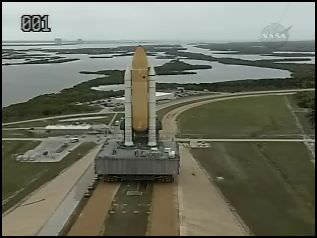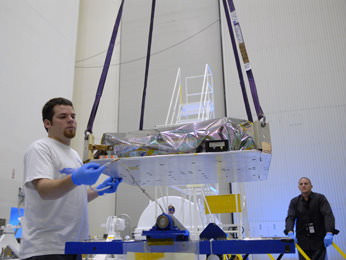NASA began the process of moving and juggling space shuttles around for the next mission, the important Hubble Telescope repair mission. Space shuttle Atlantis moved out to launch pad 39A today in preparation for the STS-125 mission, which will send seven astronauts to repair Hubble. Targeted liftoff date is May 12. Additionally, a replacement for the faulty instrument that delayed the mission last fall arrived at Kennedy Space Center, and will be loaded on the shuttle while it’s on the pad. This mission will require a second shuttle to be ready for liftoff in the event a problem arises with Atlantis in orbit, and Endeavour will head out to launch pad 39B on April 17. After Atlantis is cleared to land, Endeavour will move to Launch Pad 39A for its upcoming STS-127 mission to the International Space Station, slated to launch in mid-June. Moving a shuttle out to the launch pad takes about six hours, but this video does it in about 3 minutes – so enjoy the sped-up show; it’s a nice video showing the process.
Atlantis arrived at Launch Pad 39A at approximately 9:10 a.m. EDT Tuesday on top of a giant crawler-transporter, after leaving the Vehicle Assembly Building at 3:54 a.m. The crawler travels less than 1 mph during the 3.4-mile journey.
[/caption]
Atlantis’ 11-day mission is the final shuttle flight to Hubble. During five spacewalks, astronauts will install two new instruments, repair two inactive ones and replace other Hubble components. Their work will hopefully extend Hubble’s life through at least 2014, and give Hubble six working, complementary science instruments with better capabilities.

And if you recall, the “rescue” shuttle is necessary because Atlantis will not be going to the International Space Station, nor could it get there if a problem arose because Hubble and the ISS are in different orbits. This has been the policy ever since the Columbia shuttle accident in 2003.
Source: NASA


Excellent!
Kick arse. Lets get Hubble running to it’s FULL capability – for the very first time!
“Hubble and the ISS are in different orbits.”
Forgive me if I’m wrong… But changing orbits is impossible?
It will be nice if they can fix HST and will work great until they can get the next generation space telescope in orbit and operational.
@Erik:
No, so long as you have sufficient fuel, however the Hubble Space Telescope and the International Space Station are in quite different orbits.
The International Space Station orbits at a height of 349-358 km, and an inclination of 51.6°, where as the Hubble Space Telescope orbits at 559 km, and an inclination of 28°.
Dropping the altitude isn’t hard, but requires expending fuel to slow down, it’s really matching the inclination that’s the trouble, that also requires the expenditure of fuel, and it’s my understanding that the shuttle simply does not carry enough fuel to be able to acheive the neccessary transfer orbit.
This could be one of hte most important Shuttle missions of all time. Go Atlantis!
Erik-I’m not truly sure why the policy was changed after the disaster in 2003-besides
fuel, I did not think it would be that much of a problem on the tiles, but I’m not sure
The best news I’ve heard in a long time. I’ll believe it when it launches though… Theres a lot of time between then and now.
I will be very glad when they can repair and upgrade HST, and using safety standards to
make this mission sucessful and safe. I’m not sure when the next generation space telescope will be launched and working, but we really need HST in the meanwhile.
I will be very glad when they can repair and upgrade HST, and using safety standards to
make this mission sucessful and safe. I’m not sure when the next generation space telescope will be launched and working, but we really need HST in the meanwhile.